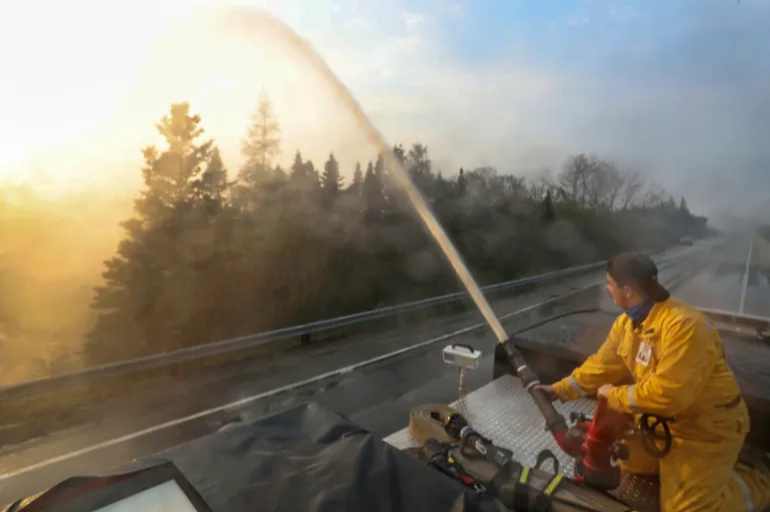
Images of orange, hazy skies across Canada and parts of US fuel calls to tackle climate crisis making wildfires worse.
Montreal, June 8 (RHC)-- "Do you smell smoke?” That’s the question people in Canada have been asking each other this week as hundreds of wildfires are burning in what has been described as an “unprecedented” start to the 2023 Canadian fire season.
Tens of thousands of people in communities across the country have been forced to evacuate as firefighters battle to contain the blazes that have scorched more than 3.8 million hectares (9.4 million acres) so far.
But the emergence of smoke-filled, discoloured skies in parts of Canada that typically aren’t affected by wildfires has spurred widespread public concern and calls for authorities to better prepare for a problem that experts say is only going to get worse.
“There’s this eerie sight of very smoky skies. It puts a yellow, greyish filter over the sun and the sky. There’s also a smell of wood-fire burning,” Caroline Brouillette, executive director of Climate Action Network Canada, said in an interview on Wednesday from Ottawa, the Canadian capital. “It does really bring home that the climate crisis is happening here and now,” Brouillette told Al Jazeera.
Images shared on social media this week showed orange-tinged skies over Ottawa, Montreal and Toronto, where a thick haze obstructed views of the CN Tower and the downtown skyline of Canada’s largest city. In New York City and Washington, DC, hundreds of kilometres from the fires burning north of the United States-Canada border, smog has filled the air.
Air pollution advisories have been issued in places across Canada as well as in states in the US Northeast and Midwest, fuelling questions about the wildfires’ effects on the health of millions of people in North America.
“From the gloom over Yankee Stadium to the smoky haze obscuring our skyline, we can see it, we can smell it and we felt it. And it was alarming and concerning,” New York City Mayor Eric Adams told reporters on Wednesday. “This is an unprecedented event in our city, and New Yorkers must take precautions,” said Adams, who urged residents to stay inside, close their windows and limit outdoor activity.
“While this may be the first time we’ve experienced something like this on this magnitude, let’s be clear: It is not the last. Climate change [has] accelerated these conditions. We must continue to draw down emissions, improve air quality and build resiliency.”
Jill Baumgartner, an associate professor in the School of Population and Global Health at McGill University in Montreal, said pollution levels in the city and in Canada more generally have been three to four times higher than usual as a result of the wildfires.
“The biggest health threat from wildfire smoke are from these very small, microscopic particles that you breathe in,” Baumgartner said, explaining that they can lead to a variety of problems from burning eyes and runny noses to chronic heart and lung diseases.
“We tend to think about wildfire smoke as being an acute or short-term exposure, but we’re seeing that we’re having these events more frequently. Wildfires are more common. They’re happening for longer periods of time,” she told Al Jazeera. “We need to start thinking about this probably [as], ‘What are the longer-term impacts of wildfire smoke on health?'”
The Canadian government said on Wednesday that more than 400 wildfires were burning across the country, including 239 that were considered out of control. More than 20,000 people remained displaced as a result of the blazes.
As of Wednesday morning, nearly 160 wildfires were burning in the province of Quebec alone, where thousands of residents have been ordered to leave their homes in the western Abitibi-Temiscamingue region. But the fires have hit many places across Canada since May – from Nova Scotia and New Brunswick on the east coast to Alberta, British Columbia and the Northwest Territories in the west.
“We haven’t seen a season like this in our modern-day record,” said Mike Flannigan, research chair for predictive services, emergency management and fire science at Thompson Rivers University in British Columbia.
Flannigan explained that climate change is largely responsible for the record wildfires as higher temperatures have extended the Canadian wildfire season and increased lightning, which is generally the cause of about half of all the blazes in the country.
A warmer atmosphere also dries out fire fuels, such as the vegetation on forest floors. These drier fuels then make it easier for fires to start and spread, and they lead to higher intensity fires that “are difficult to impossible to extinguish”, Flannigan said.
“This is our new reality,” he told Al Jazeera. “We’re on a downward trajectory. Things are going to get worse and worse and worse.”

